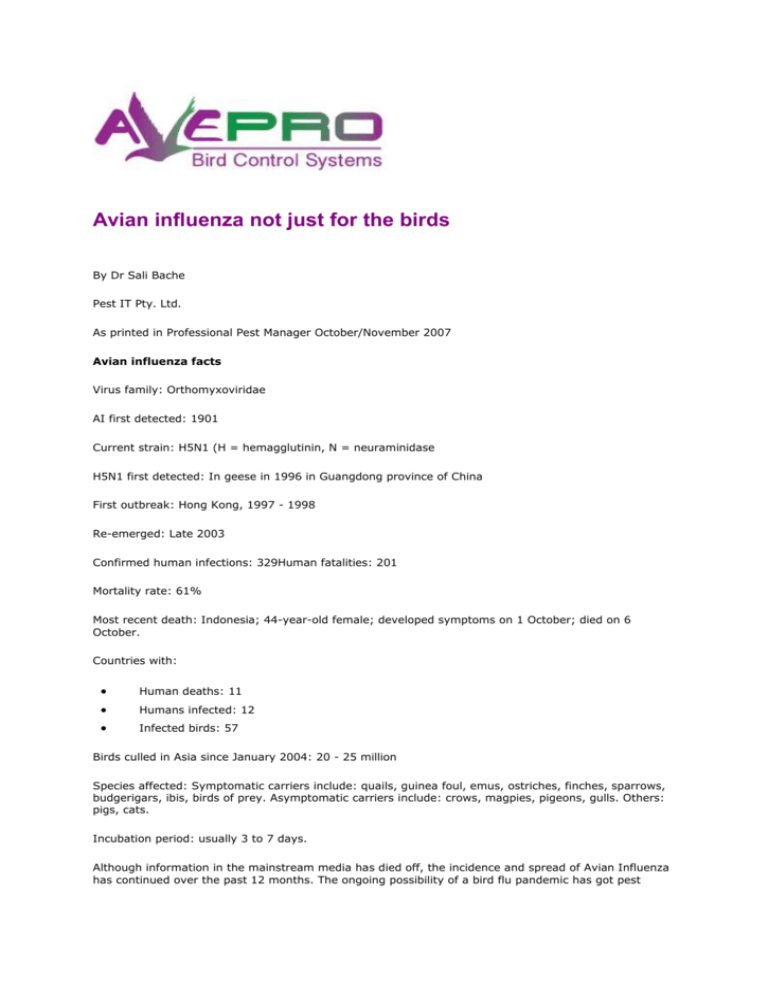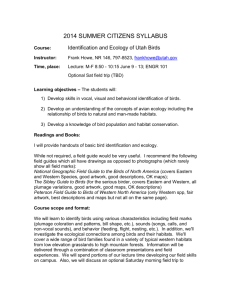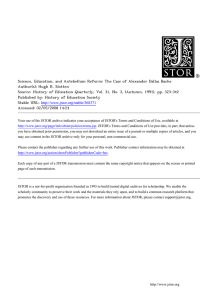Avian influenza not just for the birds
advertisement

Avian influenza not just for the birds By Dr Sali Bache Pest IT Pty. Ltd. As printed in Professional Pest Manager October/November 2007 Avian influenza facts Virus family: Orthomyxoviridae AI first detected: 1901 Current strain: H5N1 (H = hemagglutinin, N = neuraminidase H5N1 first detected: In geese in 1996 in Guangdong province of China First outbreak: Hong Kong, 1997 - 1998 Re-emerged: Late 2003 Confirmed human infections: 329Human fatalities: 201 Mortality rate: 61% Most recent death: Indonesia; 44-year-old female; developed symptoms on 1 October; died on 6 October. Countries with: Human deaths: 11 Humans infected: 12 Infected birds: 57 Birds culled in Asia since January 2004: 20 - 25 million Species affected: Symptomatic carriers include: quails, guinea foul, emus, ostriches, finches, sparrows, budgerigars, ibis, birds of prey. Asymptomatic carriers include: crows, magpies, pigeons, gulls. Others: pigs, cats. Incubation period: usually 3 to 7 days. Although information in the mainstream media has died off, the incidence and spread of Avian Influenza has continued over the past 12 months. The ongoing possibility of a bird flu pandemic has got pest managers talking, not just about the risk of being infected by the potentially deadly H5N1 virus but also about the roles they may be called on to play in controlling the spread of the disease. Biologist and director of Pest IT, Dr Sali Jayne Bache, presented a ‘wake up’ paper on avian influenza (AI) to over 500 delegates at the FAOPMAustralia 2006 conference in Brisbane in July 2006. Dr Bache said AI outbreaks in Asia and parts of Europe have already raised public awareness of the disease-carrying potential of birds and added a sense of urgency to the need to remove birds from sites. The escalating fatality rate in neighbouring Indonesia (107 cases and 86 deaths) is of particular concern to Australia. “With this awareness has also come an increased willingness to pay for bird proofing which is why bird management has become easier to sell than ever before,” she said. But, she also said, “the current state of public and official anxiety could be a short-lived phenomena. That’s why the pest management industry needs to capitalise on this new awareness while it can”. Dr Bache said while experts believe the risk of AI mutating to a form which can be spread by humans to humans is very real, it is probably not immediate. However, even if it does not mutate, pest managers could still be exposed to the virus if they come into contact with diseased or carrier birds. "So far, all documented cases of humans contracting AI have arisen from poultry. But there is no evidence to suggest that people cannot catch AI from other bird species. And, already, there have been cases of other mammals, for instance, cats, catching AI from pigeons,” she said. "Importantly, even without the threat of AI, pest managers should always use caution when interacting with birds because birds can transmit over 60 human diseases caused by fungi, bacteria, viruses, protozoa or rickettsia,” she said. Dr Bache said AI has engendered more fear and respect than all other diseases that can be passed from animals to humans because it is so contagious and pathogenic. "It was not all that long ago, in 1918, that the Spanish flu infected over a third of the world’s population and killed an estimated 50 million people,” she said. Dr Bache said the 20th century’s three ‘big’ flu outbreaks have been unusual in that they have largely targeted people in the 15 to 45 age group, normally considered to be least at risk from the severe effects of influenza infections. Disease contraction So far, there have been more than 329 confirmed cases of H5N1 avian influenza and almost one third of those affected have died. AI can be transmitted orally through saliva and nasal secretions and in faeces. Almost all people affected have been closely associated with village or backyard poultry farming and have had close contact with either infected birds or contaminated surfaces. Importantly, birds which survive AI and no longer show symptoms can be carriers for at least 10 days after they recover. Avian flu virus can survive on contaminated raw poultry or in faeces for as long as 35 days. It can also be found both inside and on the surface of eggs. Avian influenza viruses can be spread on objects and survive and spread well in contaminated water. The virus cannot be caught, however, from eating well cooked chicken or eggs. All birds are thought to be susceptible to infection, though some species are more resistant than others. "It has been long known that wild birds represent a traditional reservoir for avian influenza viruses worldwide,” Dr Bache said. "Unusually, it appears that the currently circulating H5N1 strain is also highly pathogenic to wild migratory birds including anatidae (ducks, geese and swans) which are now dying in large numbers from H5N1,” she said. "Quails, guinea fowl, emus, ostriches, passerine birds (finches and sparrows), budgerigars, ibis and birds of prey are also ‘at risk’ and there have also been confirmed recoveries of the virus from dead crows, pigeons and magpies. "Research suggests that pigeons and gulls are only minimally susceptible to avian influenza in particular the H5 subtype. However, birds that exhibit resistance to the viruses can nonetheless be asymptomatic carriers. "Importantly for pest managers, there is no evidence (yet) of any cases of contraction of H5N1 bird flu by humans from non-poultry bird species. This may, however, be because most human-bird interaction occurs primarily within a poultry farm environment.” Geographic spread Countries close to Australia where H5N1 has been detected to date are Korea, Japan, Viet Nam, Thailand, Cambodia, Laos, Indonesia, Mongolia, China and Malaysia. In these typically poor rural subsistence-farming areas, direct agricultural losses have been estimated in excess of US$10 Billion. More recently the virus has been detected in Europe in countries ranging from Russia through to the UK. Closer to home, shock waves hit Australia in 2007 when a woman died of AI in the resort island of Bali. Australia is to date free of this strain of bird flu. However, patrols of the northern region of Australia are being conducted looking for migratory birds exhibiting disease symptoms. Australia is also screening airline passengers from eleven Asian countries with particular attention to eggs, egg products and poultry. "Vigilance is also needed to counter incursions of illegal, unregulated or unreported fishing vessels coming to our north coast from Indonesia which may carry birds or animals onboard that may act as potential vectors,” Dr Bache said. Though the role of migratory birds in influenza transmission remain uncertain, Dr Bache said it is possible that birds not exhibiting signs of infection may act as vectors for long distance transmission of the influenza virus if plumage or feet are contaminated. "According to the World Health Organisation (WHO), evidence that the virus is now endemic in bird populations means that the present level of risk will not be easily diminished. The virus is expanding its geographic range increasing the size of population at risk,” she said. Role for pest managers Dr Bache said pest management companies are likely to be called in to assist in the event of an AI outbreak in Australia. Among their likely roles are: surveying facilities for pest bird interaction with employees, clients and the public; monitoring pest bird populations at client facilities; reviewing bird management options; recommending on and/or selecting appropriate (safe and effective) bird management options, including: o o o population reduction or elimination (trapping, shooting, poisoning); and installing physical deterrents (spikes, netting, electronic and other devices); installing and operating scare devices (sonic, ultrasonic, and distress calls, laser and strobe lighting); offering information on personal protection equipment (PPE) and availability; and monitoring ongoing results of bird management programs or practices. Disease Control Control of the disease in animals is the principle way to reduce opportunities for human infection. The World Health Organisation (WHO), World Organisation for Animal Health (OIE), and United Nations Food and Agricultural Organisation (FAO) all agree that the control of avian influenza infection in wild bird populations should not be attempted because it is not feasible from a logistical, environmental or biodiversity point of view. Furthermore, they believe indiscriminate culling of wild birds would be ineffective in preventing further spread of avian influenza. “Indeed the role of wild birds in the propagation, maintenance and dissemination of H5N1 remains poorly understood and unresolved,” Dr Bache said. "That is why there is an urgent need to know more about the virus and how it circulates and better understand risk contamination pathways between infected animals and humans,” she said. Measures currently being taken include: monitoring of wild birds and poultry; trade bans on affected areas; supplying information to travellers; and international cooperation through involved agencies. Governments are also stockpiling flu medications and searching for a vaccine. Although resistant to some anti-virals, H5N1 remains susceptible to neuraminidase inhibitors (Tamiflu). Current recommendations, however, are that anti-virals should not be taken for longer than 42 days. Australia is one of only eight countries with the facilities to manufacture flu vaccines. In June 2007, the WHO announced that it is working with vaccine manufactures to move ahead on plans to create a global stockpile for an H5N1 avian influenza vaccine. This task is complicated by the fact that no single specific vaccine for H5N1 has been able to be developed due to the genetic evolution of the H5N1 virus. Instead a series of vaccines to protect against H5N1 have been created taking into account variations between the H5 (haemagglutinin) genes. These would be made available to contries should a global outbreak of AI occur. Other preparations include looking at the use of public health measures such as isolation, quarantine, personal hygiene and the use of anti-virals. Personal protection equipment Dr Bache said even though AI had not yet been detected in Australia, pest managers should, as a matter of course, always practice good hygiene (washing hands after contact in soap and water for at least 1520 seconds and using standard hand disinfectant procedures) when interacting with pest birds and/or faeces. And, even though no specific recommendations that have yet been issued for people who interact regularly and closely with bird populations during a bird flu outbreak, she also recommended pest managers wear appropriate personal protection equipment such as disposable gloves of either lightweight nitrile or vinyl, or heavy weight rubber that can be disinfected. "If walking in faeces and other bird debris, wear disposable protective shoe covers or rubber or polyurethane boots that can be cleaned and disinfected,” she said. The use of disposable particulate respirators and fit-testing of respirators (to ensure a tight seal) is also recommended. In areas of known AI contamination, AUSVET states that workers should be clean-shaven. A P2 respirator that filters more than 94% of airborne particles is the minimum level that should be worn. Proper discarding of disposable goods and careful washing of hand after disposal are also recommended. "The final measure is the careful surveillance of those likely to have been exposed to H5N1. This should be continued for at least one week after exposure as the incubation period in humans is estimated at three to seven days. "Symptoms to watch for include fever and coughing, much like that of regular flu and eye infections,” Dr Bache said. "Not all cases of H5N1 have typical flu symptom of a sore throat and runny nose, however, and of greatest concern is the severe respiratory distress often seen in H5N1 cases,” she said. Decontamination Bird droppings present the greatest challenge to contamination by AI infected material because the virus can survive longer in moist environments with high organic content. "The AI virus can survive up to 35 days at 4ºC in faecal material,” Dr Bache said. "In decontaminating a site it is important to ensure that bird faeces do not become airborne and potentially infectious. Dr Bache said the FAO recommends that the treatment of faeces be undertaken by burning or burying the material if it is being disposed of along with dead carcasses. "Avian influenza belongs to the orthomyxoviridae family which are lipid containing viruses of intermediate to large size. These viruses are, therefore, very susceptible to detergents. An example of an excellent commercially available cleaning, disinfecting and decontamination is Tripple Aqua. In some circumstances, faeces decontamination may require the application of strong alkalis. Sodium hydroxide (2% for 10 minutes) or sodium carbonate anhydrous (4% for 10 to 30 minutes) are both widely and cheaply available. Neither, however, should be used with aluminium or aluminium alloys. Contaminated items, such as clothing, footwear and other equipment should be decontaminated or, if possible, or destroyed. Citric acid (0.2% for 30 minutes) is an effective decontaminant for personnel and clothing because avian influenza is rapidly inactivated at a pH of 2.5 and below. Although currently in Australia there is a very low risk, a large amount remains unknown about the current strain of AI. Regardless of H5N1, bird managers should as standard practice use PPE and clean and disinfect all sites prior to the commencement of any bird work. Pest IT Pty Ltd, Unit 5/74 – 76 Oak Road Kirrawee NSW 2232 AUSTRALIA Phone Fax: E-mail: Web: 1300 665 657 1300 665 657 info@pestIT.com www.AVEPRO.com.au and www.pestIT.com








